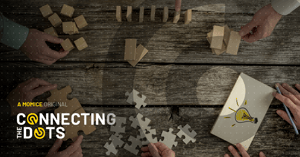Which 3 elements of your event really make the difference? Location, speaker and catering often form the top 3. But how much time do you – as an event organiser – spend on the objectives, concept and content of the programme before you get into production mode? It pays off to spend time at the drawing board – together with your client. Because real impact can only be created when your event seamlessly fits the needs of your target audience.
1. Determine proper objectives
As Momice founder Rutger Bremer explained before, formulating proper objectives proves to be a challenge for many organisations. ‘Inspiring the attendees’ or ‘sharing knowledge’ are not the real goals of an event. The ultimate goals and associated (measurable) objectives often concern issues such as conversion, sales, customer loyalty, lead generation or brand awareness.
Ensure your objectives are SMART (specific, measurable, acceptable, realistic and time bound). Everyone know these terms, but think about how often this is really put to practice. Especially realistic and measurable seem to be challenging. In order to give proper direction, it is useful to divide the objectives into smaller, achievable sub-objectives.
Proper objectives lead to a clear key message for the event (“What do you want the attendee to take home”). This is tricky. Achieving proper objectives and a clear key message requires alignment. Unfortunately, this step is often skipped. Understandable, because alignment takes time – and time is exactly what is lacking in many cases. However, you will find that taking this difficult step will lead to better results for your event!
2. Take the audience's perspective
Envisioning the target audience entails much more than collecting invitee lists. Invest time in an extensive target audience analysis, so you can tailor your event exactly to their needs. A good way to do this, is to develop one (or multiple) buyer persona(s): a detailed description of your key client or attendee. Please note: the demographics (gender, region, age, education) are not sufficient in this context. Zoom in on what moves, inspires and motivates your target audience. What are their challenges, what is their level of knowledge, what do they read, how do they see you, etc.
Chances are, the Marketing department of your organisation already developed buyer personas for important client groups. If not, involve them in the development where necessary. Researches are often available – and the sales department has lots of information about the behaviour and preferences of the client. Is something missing? Don’t hesitate to ask the one who knows best: the client itself! Involving the target audience at an early stage pays off – and increases engagement.
Read more about co-creation at events!
Remember: invitees will only register for an event when the content fits their needs. A clear image of your target audience makes it possible to address their challenges, wishes or obstacles at your event. This is the best basis for a strong and relevant programme.
3. Open the black box
The programme forms the core of your event. Still, many event organisers opt for the standard format of an ‘inspirational speaker’ followed by networking drinks. Of course, this could be a good option, provided that speaker contributes to the main goal and key message of your event. After all, you want your audience to do something - learn new things or take action. “It is therefore important to look at your target audience from that perspective”, says Gert Slob, behavioural scientist. “Only when you manage to move your target audience before and after the event, creating impact with events will be possible.”
By taking the challenges and motivations of the target audience as a starting point, the chances of hitting the mark will increase - making it easier to find the right speaker or working method. Remember: it’s the audience that determines what is relevant!
Whether you actually succeeded, you will find out if you invest time and effort in analysing and evaluating the results of your event. Only then you can determine the impact of your event – and whether the investment was worth it. Do not forget to add the data to your CRM system, in order to enrich the client data and improve the personalisation in the future.
Learn everything about evaluating your events. Download our survey white paper!
Conclusion
The saying “Look before you leap” clearly stands in this context. Do not start before the goals, target audience and strategy of your event are crystal clear – and involve your client and/or colleagues of other departments in this process. And afterwards, make sure to evaluate the results.
Connecting the Dots
Because Connecting the Dots is a Dutch-language event, it is less suitable for English speaking attendees. However, we feel the articles we write about this topic could be of added value for all event professionals. Are you interested in the content? Read more here!

